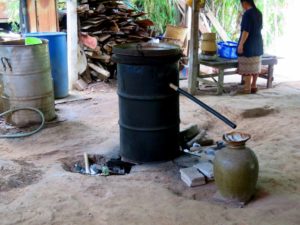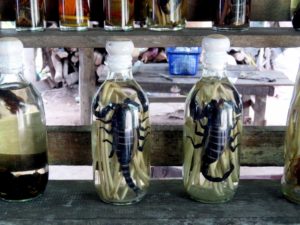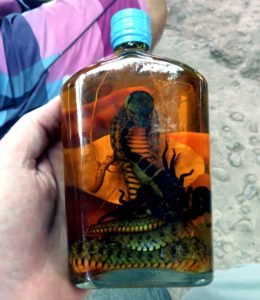19 Sep Laos — Up the Mekong to the Whiskey Village
While I was growing up, the Georgia Department of Revenue ran public service announcements warning against untaxed liquor. Alcohol that isn’t taxed isn’t regulated and, if it isn’t regulated, there’s no telling what you might get. Moonshiners aren’t sanitary. Moonshiners often don’t use the best of equipment. Sometimes moonshiners even stretch out their product with antifreeze, and drinking antifreeze isn’t good for you.
When I got older it occurred to me that any organization whose name involved “Revenue” might have a conflict of interest when it came to untaxed anything. It also occurred to me, why antifreeze? Antifreeze cost money and corn was so cheap people fed it to livestock. It seemed a lot more likely that you’d have to worry about somebody stretching antifreeze with corn liquor. But you never heard public service announcements warning you off untaxed antifreeze.
Years later, my sister was living in a pasture near the Tennessee-Kentucky line while she and her husband built their house. Peg and I visited and, in honor of our coming, they held a moonshine tasting . . . 6 or 8 mason jars of bourbon collected from neigh bors. None of it tasted like antifreeze to me. In fact, some of it tasted pretty damn good, and none of us died. So I had a warm spot in my heart for homemade whiskey the morning Peg and I hove up on the banks of the Mekong at a place the residents call Ban Xang Hai. Everybody else calls the place the Whiskey Village because that’s what it’s famous for, and because “Whiskey Village” is a lot easier to remember than “Ban Xang Hai.”
It’s in Laos upriver from Luang Prabang, and a motorized sampan landed us on a small, floating bamboo dock tethered at the foot a steep, muddy bank.

The whiskey part of the Whiskey Village is in a shed right at the top of the bank so you don’t actually have to go into the village to get your whiskey. What first caught our eye were a couple of shelves of bottles, a toddler playing peek-a-boo among fifty-five gallon drums, and the blackened still

that was the center of the entire whiskey industry.
One look at that still made all those self-serving public-service pronouncements seem like they might have been onto something . . . although I wasn’t any more certain about the antifreeze bit than I’d been in Georgia. Even in Laos . . . maybe even especially in Laos . . . antifreeze would be more expensive than anything that was supposed to go into that still. In any event, whatever came out was definitely something you’d want to steer clear of.
I knew that the banks of the Mekong aren’t exactly corn country, so I hadn’t been expecting Kentucky bourbon. I was hoping it wouldn’t turn out to be made from rice, but I kind of suspected it might. What I wasn’t expecting was scorpions.

Big, bluish scorpions. The kind of scorpions that could paralyze an elephant. The kind of scorpions that made the liquor seem like the savoriest part of the entire cuisine. The kind of scorpions that raise questions, like,
“Where do the villagers get them?”
An old man told me he went into the forests and hunted for scorpions. Which struck me as more alarming than actually drinking from the bottles.
My next question was, “How do you get them into the bottles?” The scorpions were much too big to slide through the necks.
The English the villagers spoke wasn’t that great. And my Laotian, if that’s what they speak in Ban Xang Hai, wasn’t even that good. But I do speak gesture and it was pretty clear the villagers understood the question. It was just that they didn’t want to reveal any secrets of the trade and acted embarrassed and hemmed and hawed and changed the subject. So, here’s my analysis of how the scorpions get into the bottles:
1: There aren’t any glass foundries in Ban Xang Hai, so I don’t think they build the bottles around the scorpions. Besides, who’d want to build a bottle around an angry, hissing, tail-thrashing, elephant-killing scorpion?
2: The scorpions really are scorpions, so that lets out an old fellow in a shop behind the temple assembling scorpions in a bottle the way old fellows in Maine assemble ships in bottles. Therefore, after eliminating the impossible, I am forced to conclude that:
3: The villagers grow them in there from baby scorpions. Which suggests there’s a basement somewhere in Ban Xang Hai with a hidden scorpion farm. And scorpion keepers moving from bottle to bottle dropping in chunks of raw flesh from chop sticks.
I wasn’t finished with my analysis of the scorpion problem when a German who’d been on the sampan with us decided he wanted to take home a souvenir, and pulled out a bottle with a more golden hue than the ones we’d been looking at. I’m not sure where the color came from, but the scorpion inside was a brownish color, so that might have had something to do with it. Or it may have been the snake.

Which raised a whole new slew of questions, like,
Why?
And, “Did they grow the scorpion in there and drop the snake in on top?”
And, “Did the scorpion and the snake fight to the death?”
And, “Did villagers wager on the outcome?”
And, “Were there odds?
And, “If so, how do you calculate them?”
And, “Did the scorpion have the advantage because it knew the territory?”
Or, “Did the snake have the advantage because it suddenly dropped in on an unsuspecting scorpion?”
However it worked, it struck me that I had a lot to learn if I was ever going to risk money on a snake-v-scorpion death match.
It also struck me that the German was going to have trouble getting that bottle into Germany. Not because of the scorpion and the snake, but maybe because of them, now that I think about it. Maybe the scorpion and the snake are on a list of rare, threatened scorpions and critically endangered snakes that was going to get the German arrested at the border. Maybe there’s a whole illegal trade in rare, threatened scorpions and critically endangered snakes. Maybe downing a bottle of schnapps with a rare, threatened scorpion or a critically endangered snake inside is de rigueur if you’re a German student and belong to an outlaw university dueling club. Maybe. But, more likely, this particular German was going to get stopped because of the moonshine. Everybody knows that a bottle with more than a hundred milliliters of liquid anything isn’t going to make it onto an airplane. And, when I reflect upon it some more, maybe the security people are right. Maybe the liquid in that particular bottle really could bring down a 747.


No Comments